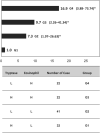Blood tryptase and thymic stromal lymphopoietin levels predict the risk of exacerbation in severe asthma
- PMID: 33875671
- PMCID: PMC8055991
- DOI: 10.1038/s41598-021-86179-1
Blood tryptase and thymic stromal lymphopoietin levels predict the risk of exacerbation in severe asthma
Abstract
Some patients with severe asthma experience exacerbations despite receiving multiple therapy. The risk of exacerbation and heterogeneous response to treatment may be associated with specific inflammatory molecules that are responsive or resistant to corticosteroids. We aimed to identify the independent factors predictive for the future risk of exacerbation in patients with severe asthma. In this multi-center prospective observational study, 132 patients with severe asthma were enrolled and divided into exacerbation (n = 52) and non-exacerbation (n = 80) groups on the basis of exacerbation rate after a 1-year follow-up period. We found that previous history of severe-to-serious exacerbation, baseline blood eosinophil counts (≥ 291cells/μL), and serum tryptase (≤ 1448 pg/mL) and thrymic stromal lymphopoietin (TSLP) levels (≥ 25 pg/mL) independently predicted the future development of exacerbation with adjusted odds ratios (AOR) of 3.27, 6.04, 2.53 and 8.67, respectively. Notably, the patients with high blood eosinophil counts and low tryptase levels were likely to have more exacerbations than those with low blood eosinophil counts and high tryptase levels (AOR 16.9). TSLP potentially played the pathogenic role across different asthma phenotypes. TSLP and tryptase levels may be implicated in steroid resistance and responsiveness in the asthma inflammatory process. High blood eosinophil counts and low serum tryptase levels predict a high probability of future asthma exacerbation.
Conflict of interest statement
The authors declare no competing interests.
Figures


References
-
- Global Initiative for Asthma. Global Strategy for Asthma Management and Prevention. https://www.ginasthma.org (2019).
-
- Akinbami LJ, Moorman JE, Liu X. Asthma prevalence, health care use, and mortality: United States, 2005–2009. Natl. Health Stat. Rep. 2011;32:1–14. - PubMed
-
- Reddel, H.K., et.al., American Thoracic Society/European Respiratory Society Task Force on Asthma Control and Exacerbations. An official American Thoracic Society/European Respiratory Society statement: Asthma control and exacerbations: standardizing endpoints for clinical asthma trials and clinical practice. Am. J. Respir. Crit. Care Med.180, 59–99 (2009). - PubMed
Publication types
MeSH terms
Substances
LinkOut - more resources
Full Text Sources
Other Literature Sources
Medical

